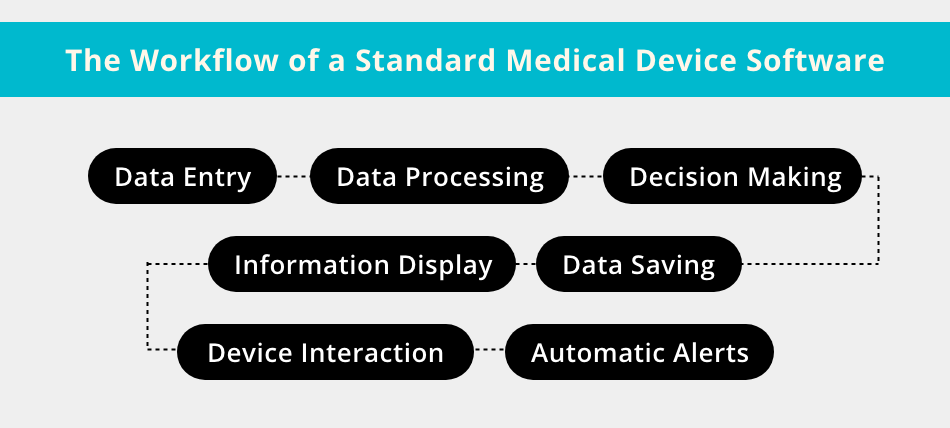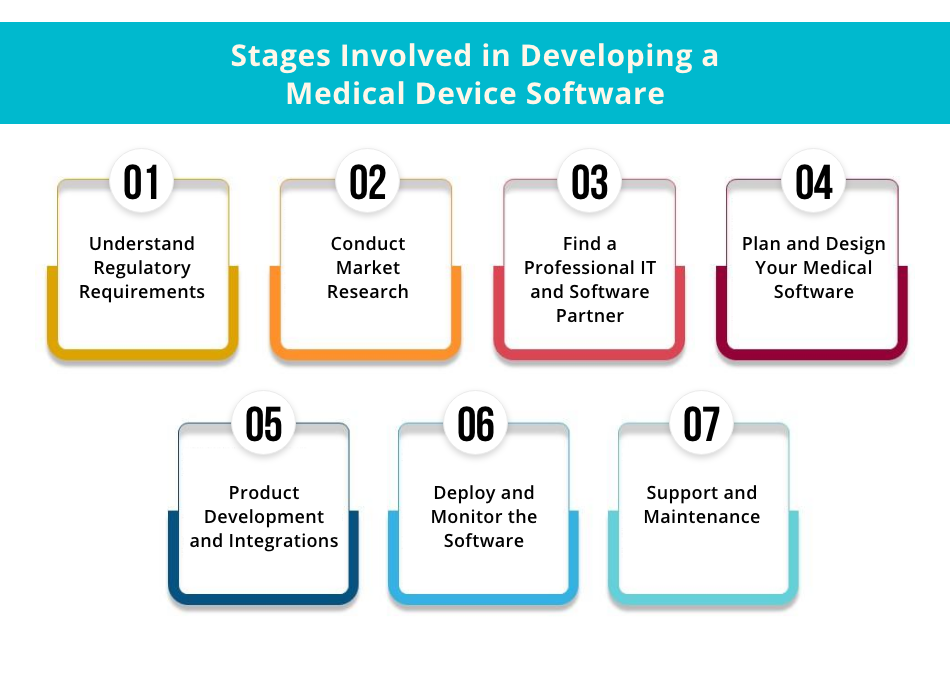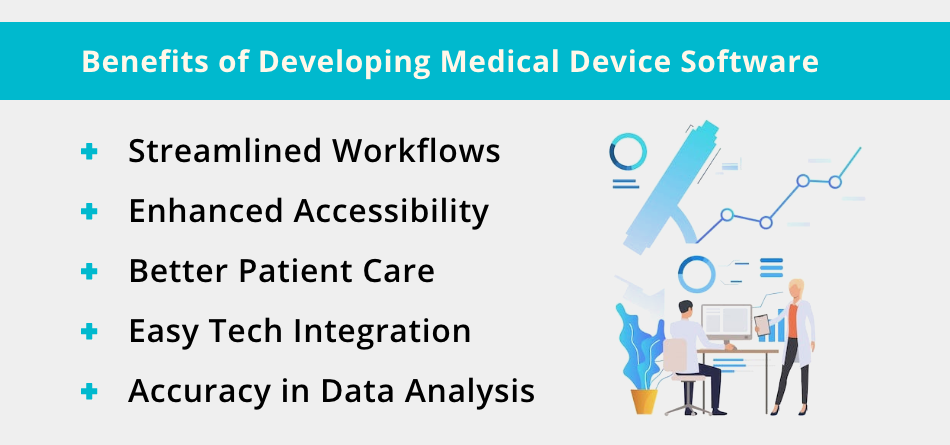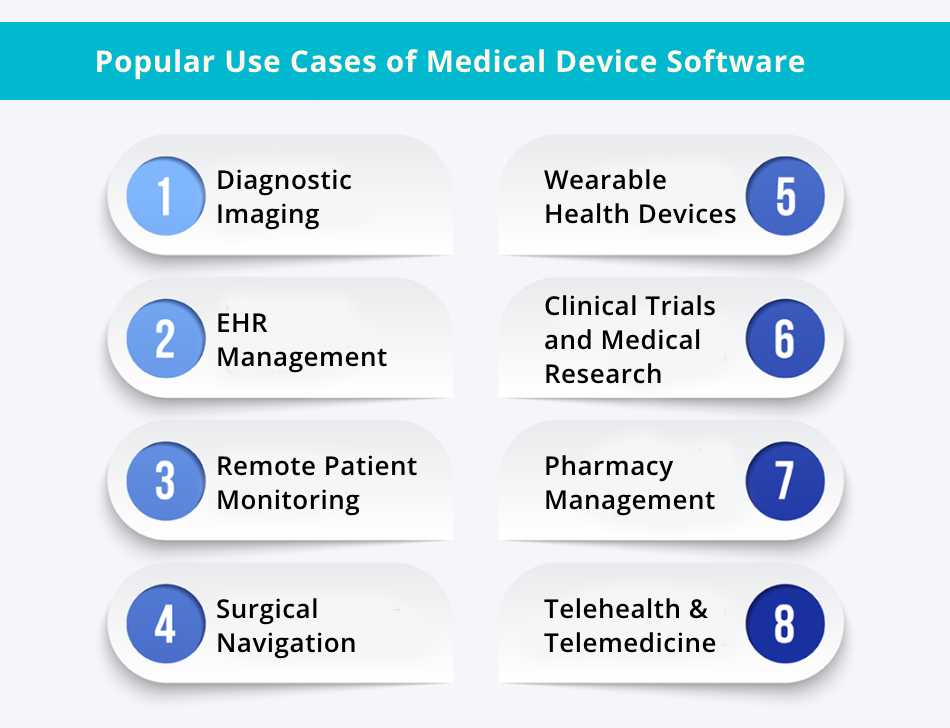The ever-evolving healthcare industry needs to invest in advanced medical device software development to provide improved and convenient medicare services.
Updated 15 April 2024

CTO at Appventurez
From treatment monitoring systems to diagnostic tools, the implementation of digital technologies has reimagined the face of the healthcare industry. At the forefront of this massive transformation lies Software as a Medical Device (SaMD), unlocking opportunities in the creation of advanced, life-enhancing devices.
With the ongoing advancements in the healthcare domain, medical device software development is on the surge. Businesses in this sector often collaborate with a professional healthcare app development company to build highly efficient software for portable medical devices.
This informational piece will brief you on medical software development, its benefits, and the factors to consider. Besides, we will also discuss how to create a medical device solution by following a strategic development process.
Medical device software development is the process of building a standalone program that is designed to perform healthcare functions independently. Medical device software covers a wide range of operations, such as patient monitoring, diagnostics, and treatment.
The popularity of software development for medical devices has risen due to the ever-evolving growth of IoT-enabled systems, smart healthcare solutions, and wearable devices. The working mechanism of a medical device software largely depends on the type of medical equipment and the functions it performs. Below is a schematic diagram of how medical software works.

With seamless medical device software development, healthcare institutions can improve medical care by:
When it comes to medical device software, the classification is divided into two major types:
Software as a medical device classification covers all software programs without the need for special medical equipment. Such types of devices are regulated by the same standards as other medical devices or instruments. They can be further integrated with other embedded systems during the medical device software development process.
As the name suggests, embedded medical software is designed and developed to work inside a medical device. These software solutions are further incorporated directly into the hardware. With this, the medical equipment can function without connecting to external systems or servers.
| Software as a Medical Device (SaMD) | Embedded Medical Software System |
|---|---|
| Works on smartphones, tablets, and desktops | Works on special medical equipment |
| Since it is subjected to higher risk classification, SaMD is often regulated as a medical device | Since it is an integral part of a medical device, embedded medical software is excluded from regulations. |
| Used in telemedicine platforms, electronic health record systems, and healthcare data analytics tools | Used in smart wearable health devices, medical imaging systems, and glucose monitoring systems |
Users often see medical device software development as a complex process. This is because when it comes to software development for medical devices, one needs to have a profound understanding of the nature of such solutions.
Below we have discussed the step-by-step guide to develop an application software for medical devices.

While developing medical devices and healthcare equipment, the first and foremost thing to consider is understanding the regulatory requirements. The main regulatory bodies that govern medical device software development are:
Maintaining compliance with these regulatory requirements is essential to authorize software development for medical devices.
After ensuring that your medical device idea aligns with the necessary regulatory requirements, the next step is to clarify your user requirements and understand the market needs. This stage of medical device software development is crucial as it helps you better explore your target audience.
Within this stage of medical device software engineering, you need to:
The next stage of the medical device software development life cycle is a crucial one. In this phase, you scour the market and look for an ideal software development partner for your business needs. To find a suitable software development company, you need to:
The roles and responsibilities of a software development company are critical as they ensure that the entire medical device software development process executes successfully.
In the planning stage, you need to collaborate with the software development company to successfully develop software as a medical device. This phase focuses on conducting a comprehensive analysis of user needs, software requirements, third-party integrations, and features to be incorporated.
This is also one of the important medical device development phases as the architecture of your medical device software is formulated in this stage. A solutions architect is primarily responsible for choosing the app’s architecture, which can be further developed, deployed, and scaled accordingly.
Besides, this stage also focuses on the medical device software design. Deciding on the specific elements, themes, and templates will help the UI/UX team to develop a flawless, easily navigable user interface.
After you have planned your software’s architecture, you need to start building the core modules and features of your medical software. Based on your project needs and business objectives, you can pick any one of the two approaches to medical device software development.
Start with a minimum viable product (MVP) first. Building an MVP for startups focuses on creating the minimal yet most important functionalities of the software. This is an ideal strategy as the cost of building an MVP is quite low, which is great for startups with budget constraints.
In this approach, a proof of concept in software development is built and utilized by the development team. With this method, you can determine the feasibility of your healthcare system, ensuring seamless integrations and unmatched performance.
Once you pick an approach, your development partner will choose a specific set of tools and technologies to start building your software. Integrate the necessary APIs and libraries and conduct QA testing to ensure the quality of the developed solution.
Once the development and testing phase of your medical devices development process is complete, your software development partner will deploy it for release. This is the stage when the developers will train your staff about the developed software solution, create a user manual, and offer you all the necessary documentation.
Once you are confident that the developed solution is ready to be deployed, release the software to conclude your medical device software development process. Make sure you constantly check its performance and ensure they are compliant with security standards.
Although this stage might not technically count in the medical device software development process, it is a crucial part of the post-development phase. Once your app is live and your targeted audience uses it, you need to monitor the feedback, requests, and issues submitted by them.
In this stage, the technical support and customer services team primarily need to focus on:
A reliable and professional medical equipment development partner will help you with post-development support and maintenance services, ensuring that your solution delivers consistent performance.
By developing medical devices integrated with advanced software programs, you obtain enhanced efficiency and ensure assured safety while delivering healthcare services. Below are some of the notable benefits of developing medical software.

With seamless medical device software engineering, you can create and integrate an efficient solution to optimize operational workflows and improve productivity in healthcare. These solutions help businesses in this sector to shift their focus from administrative roles to patient-oriented services.
Medical device software development scales healthcare services beyond traditional clinical environments, improving accessibility for patients seeking immediate, affordable, and convenient medical assistance.
One of the prominent benefits of indulging in medical equipment development is that it enables precise diagnostics, custom treatment plans, and advanced monitoring. All this helps in providing enhanced patient care.
By implementing advanced tech solutions, such as AI development services, IoT integration, or cloud computing in healthcare, the performance and functionalities of the devices can be significantly improved. Consequently, it helps medical institutions offer better care with effective healthcare solutions.
Software as a medical device also helps in better data classification and analysis, empowering businesses in the healthcare industry to derive actionable insights. This is imperative for informed decision-making and gaining a competitive edge in the market.
Developing medical software and utilizing its potential can be significantly impactful for businesses in the healthcare domain. Here are some of the popular use cases of medical device software:

Software used in medical imaging devices can significantly boost their diagnostic capabilities, aiding healthcare practitioners to analyze images, such as CT scans, MRIs, and X-rays better. This software can also detect several medical conditions in their initial stages.
An EHR solution is another notable medical device software that helps maintain and streamline patients’ electronic health records. This software as a medical device system ensures easy upkeep of patients’ medical records and enhances patient-hospital communication.
Seamless medical device software development provides healthcare providers with an ideal solution to monitor patients remotely and track their health status in real time. It’s crucial for patients suffering from chronic diseases who need constant monitoring.
Medical device software can help surgeons strategically plan critical procedures by generating 3D anatomy models of patients that simulate surgery outcomes. These models can aid surgeons by providing real-time assistance while performing surgeries.
Healthcare devices integrated with wearable app development services empower users to monitor various health metrics, such as oxygen levels, blood sugar levels, heartbeat count, sleeping patterns, and activity tracking.
Another important use case of medical device software development is clinical trials and research. These software solutions help medical researchers to collect, analyze, and maintain data, making the research accurate and efficient.
Developing medical device software can also help pharmaceutical businesses and pharmacy stores. With pharmacy management software development, businesses can easily manage medications, handle inventories, and improve medication adherence.
Medical device software also supports telemedicine and telehealth services, allowing healthcare providers to deliver healthcare solutions to patients from remote locations. This application of medical device software development includes remote monitoring, virtual consultations, etc.
From improving patient care to assisting healthcare service providers, medical device software emerged as a catalyst for progress. However, developing medical software requires specific expertise and command over technology and software development.
With over a decade of experience, Appventurez has been crafting immersive and seamless software solutions for businesses across diverse industries. As a leading software development company, we have a proven track record of delivering customer-centric and innovation-intensive healthcare solutions.
Our healthcare app developers are familiar with the entire medical devices development process, ensuring that your software solution aligns with your needs. Moreover, by implementing intuitive cloud development services and IoT solutions, our developers boost the capabilities of your medical device software.
We have already developed a couple of innovative solutions for businesses in the healthcare and medical domain. Some of the prominent examples include:
If you have a unique medical device idea that can significantly contribute to the healthcare domain, we are here to help you. Contact us to help you with medical device software development and generate a solution capable of shaping a healthier future.
Q. What are the factors to take into consideration while developing medical software?
While considering medical device software development, you must ensure your proposed solution adheres to regulatory compliance, risk management, interoperability, security practices, usability, and continuous improvement.
Q. How to create a medical device software solution?
To create medical device software, you must define your requirements, conduct market research, and find a suitable software development company. The further medical devices development process includes planning, designing, developing, testing, and deploying your software.
Q. What are some examples of software as a medical device?
Some prominent examples of medical device software are remote monitoring systems, image diagnostic software, pharmacy management systems, health tracking apps, and wearable devices.


Elevate your journey and empower your choices with our insightful guidance.

CTO at Appventurez
CTO and Co-Founder at Appventurez, Sitaram Sharma has 10+ years of experience in providing world-class digital solutions. As a CTO, he brought his expertise ranging from product enhancements to advanced technological integrations, while focusing on the consistent growth of the team.
You’re just one step away from turning your idea into a global product.
Everything begins with a simple conversation.